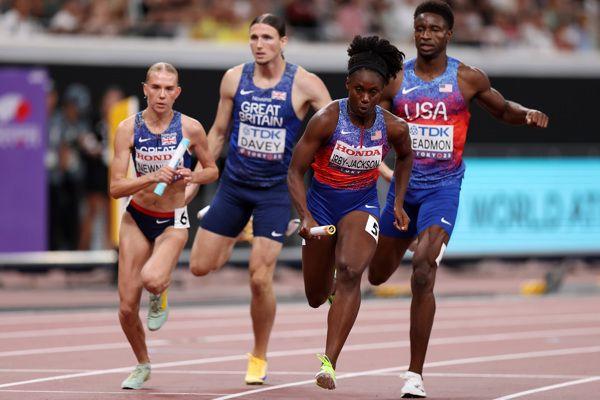The World Athletics Championships showcase the pinnacle of track and field excellence, with athletes from around the globe competing for glory. Among the most demanding events is the heptathlon, a grueling two-day competition that tests speed, strength, and endurance across seven distinct disciplines. But how exactly is this complex event scored? In this article, BBC Sport breaks down the heptathlon scoring system, explaining how performances in each event translate into points and ultimately determine the overall winner.
Understanding the Scoring System Behind Heptathlon Events
Each heptathlon event is scored using a points system that translates athletes’ performances into numerical values, allowing for an objective comparison across seven distinct disciplines. The scoring formulas, calibrated by World Athletics, consider factors such as time, distance, and height to ensure fairness and consistency. For track events, faster times yield higher points, while in field events, longer throws or jumps increase scores. This method effectively balances speed, strength, and endurance, highlighting the versatility required to excel in the heptathlon.
The scoring system is governed by three main formulas tailored to the type of event:
- Track events (e.g., 200m, 800m): Points = a × (b − P)c
- Throwing events (e.g., shot put, javelin): Points = a × (P − b)c
- Jumping events (e.g., high jump, long jump): Points = a × (P − b)c
| Event | a (constant) | b (constant) | c (exponent) |
|---|---|---|---|
| 100m Hurdles | 9.23076 | 26.7 | 1.835 |
| High Jump | 1.84523 | 75.0 | 1.348 |
| Shot Put | 56.0211 | 1.5 | 1.05 |
| 200m | 4.99087 | 42.5 | 1.81 |
Key Factors Influencing Athlete Performance in the Heptathlon
The heptathlon demands an exceptional blend of speed, strength, endurance, and technique across its seven diverse disciplines. Athletes must seamlessly transition from explosive events like the 100m hurdles and shot put to endurance-based challenges such as the 800m run. Training regimens are meticulously balanced to improve both anaerobic power and aerobic capacity, while also honing technical skills required for the high jump and javelin throw. Mental resilience plays a crucial role, as competitors face continuous pressure to accumulate points in each event without succumbing to fatigue or injury.
Several external factors also influence performance outcomes. Weather conditions, such as wind and temperature, can directly impact times and distances, especially in track events and throws. Additionally, recovery strategies between events-nutrition, hydration, and rest-are pivotal for sustaining peak physical condition over the two-day competition. Below is a breakdown of key components affecting athlete performance:
- Physical Conditioning: Strength, speed, flexibility, and endurance training tailored for multi-event demands.
- Technical Proficiency: Mastery of form and technique in field events to maximize efficiency and distance.
- Mental Fortitude: Focus, adaptability, and stress management during consecutive competitions.
- Environmental Variables: Weather and facility conditions influencing event execution.
- Recovery & Nutrition: Effective strategies to maintain energy levels between events.
| Factor | Impact on Performance | Example |
|---|---|---|
| Speed | Critical for track events like 200m and hurdles | Improved 100m hurdles time boosts overall score |
| Strength | Enhances throwing distance and jump power | Stronger shot put increases points tally |
| Technique | Makes execution more efficient, reducing injury risk | Correct javelin angle results in longer throws |
| Mental Focus | Helps maintain consistency across events | Steady performance under championship pressure |
Expert Tips for Maximizing Points Across All Seven Disciplines
Success in the heptathlon hinges on strategically balancing energy and skill across events. Specialists often highlight the need to capitalize on strengths early; for example, athletes strong in sprint events should push hard in the 100m hurdles and 200m to build a solid points foundation. Meanwhile, technical events like the high jump and javelin require meticulous attention to form and consistency-minimizing fouls here can dramatically preserve and boost overall scores. Efficient recovery tactics between events are equally crucial, enabling competitors to maintain peak performance throughout the demanding two-day schedule.
Optimizing points requires understanding how each discipline’s scoring formula rewards incremental improvements. Instead of focusing on personal bests in isolation, athletes can benefit from targeting achievable gains that yield substantial point increments. For instance:
- Improving 100m hurdles time by 0.1 seconds can add 10+ points.
- Adding just 5 cm in the long jump offers a tangible boost.
- Enhancing throwing distances by small margins frequently results in significant scoring jumps.
| Discipline | Key Tip | Point Gain Potential |
|---|---|---|
| 100m Hurdles | Explosive start and hurdle technique | +12 points per 0.1s saved |
| High Jump | Consistent approach and timing | +17 points per 5 cm |
| Javelin | Optimal grip and release angle | +10 points per 2 m |
To Conclude
As the World Athletics Championships continue to captivate audiences worldwide, understanding the intricacies of events like the heptathlon adds depth to the viewing experience. The scoring system, which translates performances across seven diverse disciplines into a single points total, remains a testament to the athletes’ versatility and endurance. With every jump, throw, and sprint, competitors not only chase personal bests but also the coveted title of the world’s most complete female athlete. Stay tuned to BBC for comprehensive coverage and expert analysis as the heptathlon unfolds on the global stage.

